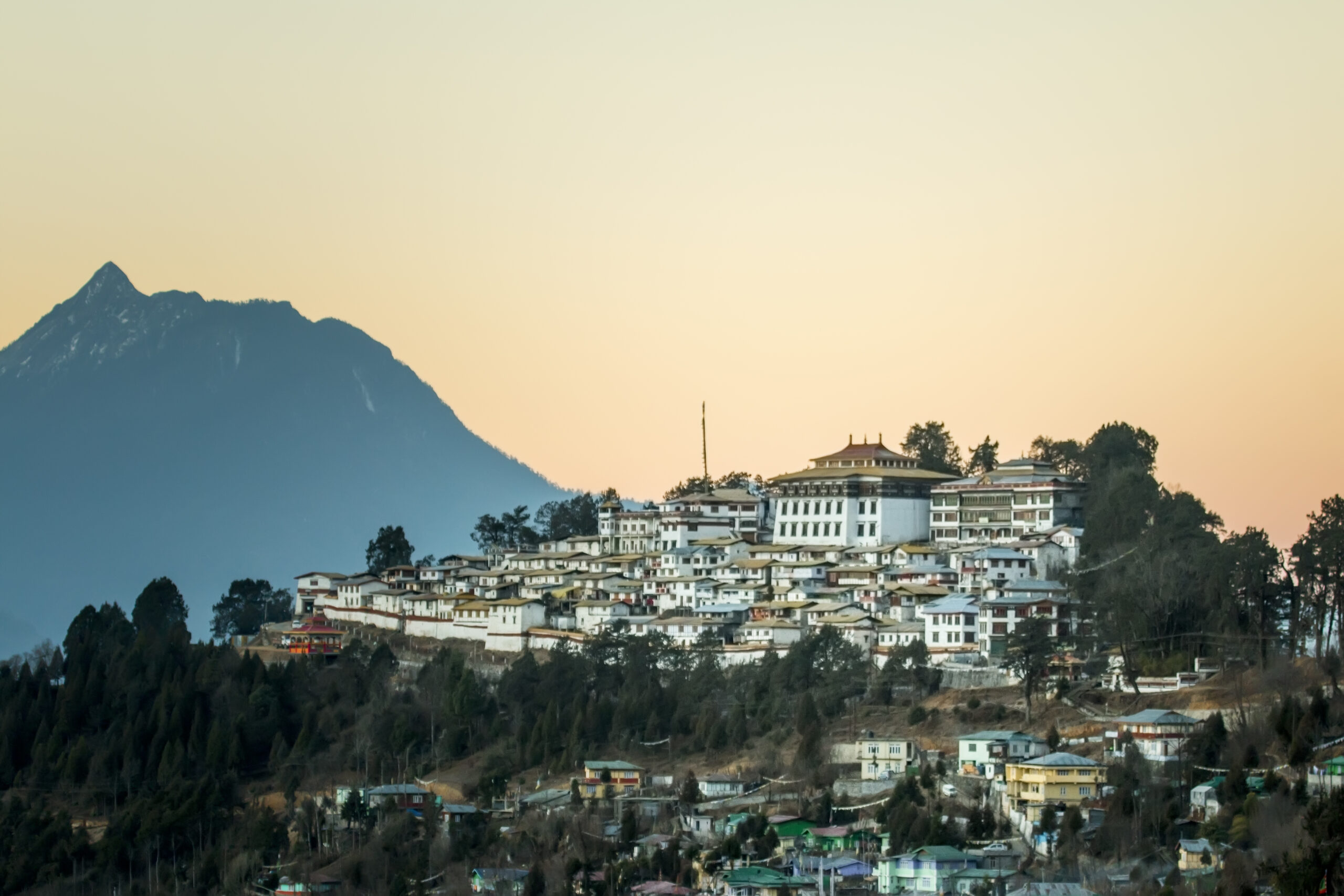Table of Contents
India is a land of diverse religions, and Buddhism has deep roots in the country’s spiritual and cultural heritage. With serene settings, rich history, and stunning architecture, the monasteries in India are not only centers of worship but also hubs for meditation, learning, and cultural preservation. From the snow-clad Himalayas to the lush valleys of the Northeast, Buddhist monasteries spread across India attract pilgrims, historians, and tourists from all over the world.
In this article, we will delve into the major monasteries in India, with a particular focus on the most famous Buddhist monasteries, their locations, historical significance, and travel details.
What Are Buddhist Monasteries?
Buddhist monasteries are religious institutions where monks live, meditate, study Buddhist scriptures, and teach the Dharma (Buddha’s teachings). These monasteries often include prayer halls, stupas, meditation rooms, libraries, and living quarters. They serve as places of worship, learning, and community gatherings.
Why Visit Buddhist Monasteries in India?
-
Spiritual Experience: Meditate and experience peace in serene environments.
-
Historical Importance: Explore ancient sites dating back to the time of Lord Buddha.
-
Architectural Beauty: Witness unique Indo-Tibetan and Indian styles of architecture.
-
Cultural Insight: Learn about Buddhist rituals, festivals, and monastic traditions.
List of Major and Famous Buddhist Monasteries in India
| S.No. | Monastery Name | Location | Buddhist Sect |
|---|---|---|---|
| 1 | Tawang Monastery | Tawang, Arunachal Pradesh | Mahayana |
| 2 | Rumtek Monastery | Gangtok, Sikkim | Kagyu |
| 3 | Hemis Monastery | Hemis, Ladakh | Drukpa Lineage |
| 4 | Thiksey Monastery | Near Leh, Ladakh | Gelugpa |
| 5 | Alchi Monastery | Alchi, Ladakh | Mahayana |
| 6 | Nalanda Monastery | Nalanda, Bihar | Mahayana |
| 7 | Sera Monastery | Bylakuppe, Karnataka | Gelugpa |
| 8 | Drepung Monastery | Bylakuppe, Karnataka | Gelugpa |
| 9 | Tushita Meditation Centre | Dharamshala, Himachal Pradesh | Mahayana |
| 10 | Ralang Monastery | Ravangla, Sikkim | Kagyu |
| 11 | Phugtal Monastery | Zanskar, Ladakh | Gelugpa |
| 12 | Mindrolling Monastery | Dehradun, Uttarakhand | Nyingma |
| 13 | Namdroling Monastery | Bylakuppe, Karnataka | Nyingma |
| 14 | Tabo Monastery | Spiti Valley, Himachal Pradesh | Gelugpa (Originally Mahayana) |
1. Tawang Monastery, Arunachal Pradesh
-
Overview: The largest monastery in India and second largest in the world, Tawang Monastery is perched at an altitude of about 3,048 meters.
-
Founded: 17th century by Merak Lama Lodre Gyatso.
-
Significance: Center of Mahayana Buddhism, renowned for its annual Torgya festival.
-
Architecture: Tibetan-style monastery with prayer halls and statues of Buddha.
-
Location: Tawang, Arunachal Pradesh.
2. Rumtek Monastery, Sikkim
-
Overview: Known as the Dharma Chakra Centre, Rumtek Monastery is one of the most important monasteries of the Kagyu sect.
-
Founded: 16th century, rebuilt in the 1960s.
-
Significance: Seat of the Karmapa Lama in exile.
-
Architecture: Large prayer halls, murals, and sacred statues.
-
Location: Near Gangtok, Sikkim.
3. Hemis Monastery, Ladakh
-
Overview: One of the richest and largest monasteries in Ladakh, famous for its annual Hemis festival.
-
Founded: 1630 AD by Stagsang Raspa.
-
Significance: Holds valuable relics and ancient manuscripts.
-
Architecture: Tibetan style with beautiful murals and prayer flags.
-
Location: Hemis village, Ladakh, Jammu & Kashmir.
4. Thiksey Monastery, Ladakh
-
Overview: Resembling the Potala Palace of Lhasa, this monastery houses a large statue of Maitreya Buddha.
-
Founded: 15th century.
-
Significance: Important Gelugpa sect monastery, known for spiritual teachings.
-
Architecture: Multi-story complex with stupas and assembly halls.
-
Location: Near Leh, Ladakh.
5. Alchi Monastery, Ladakh
-
Overview: One of the oldest monasteries in Ladakh, famous for its 11th-century wall paintings.
-
Founded: 11th century.
-
Significance: Showcases Indo-Tibetan art and ancient Buddhist culture.
-
Architecture: Unique Kashmiri influence on architecture.
-
Location: Alchi village, Ladakh.
6. Nalanda Monastery, Bihar
-
Overview: Though the original Nalanda University ruins are famous, Nalanda Monastery is a modern Tibetan monastery inspired by the ancient seat of learning.
-
Founded: 20th century.
-
Significance: Spiritual center and educational institute.
-
Architecture: Tibetan Buddhist style.
-
Location: Near Rajgir, Bihar.
7. Sera Monastery, Karnataka
-
Overview: One of the “Big Three” Gelugpa university monasteries of Tibet, established in exile.
-
Founded: 15th century in Tibet; Sera in India was established later.
-
Significance: Famous for the monastic debates held here.
-
Architecture: Traditional Tibetan style.
-
Location: Bylakuppe, near Mysuru, Karnataka.
8. Drepung Monastery, Karnataka
-
Overview: Another of the “Big Three” Tibetan monasteries in exile.
-
Founded: Originally 1416 in Tibet; the Indian branch was set up in Karnataka.
-
Significance: Seat of many Dalai Lamas.
-
Location: Bylakuppe, Karnataka.
9. Tushita Meditation Centre, Himachal Pradesh
-
Overview: A modern center focused on Tibetan Mahayana meditation.
-
Founded: Late 20th century.
-
Significance: Popular with international Buddhist practitioners.
-
Location: Dharamshala, Himachal Pradesh.
10. Gangtey Monastery, Sikkim
-
Overview: An important Nyingmapa monastery and home to the Black-necked Crane festival.
-
Founded: 17th century.
-
Significance: Preserves ancient rituals and Tibetan culture.
-
Location: Phobjikha Valley, Sikkim.
Other Notable Buddhist Monasteries in India
-
Tibetan Buddhist Monastery, McLeod Ganj (Himachal Pradesh)
-
Phugtal Monastery, Ladakh
-
Ralang Monastery, Sikkim
-
Tholing Monastery, Ladakh
-
Mindrolling Monastery, Dehradun
How to Reach Major Buddhist Monasteries in India?
-
By Air: Nearest airports include Guwahati (for Tawang), Bagdogra (for Sikkim), Leh (for Ladakh), and Dharamshala (for Himachal).
-
By Train: Nearest major railway stations are in Guwahati, New Jalpaiguri (Siliguri), Pathankot, and Chandigarh.
-
By Road: Well-connected roads and local taxis are available to reach monasteries, though some are located in remote mountainous regions.
Best Time to Visit Buddhist Monasteries in India
-
Spring (March to June): Pleasant weather and colorful festivals.
-
Autumn (September to November): Clear skies and vibrant cultural events.
-
Winter: Some monasteries may be closed or difficult to access due to snow.
Significance of Buddhist Monasteries in Indian Culture
-
Preserve the ancient teachings of Buddha.
-
Promote peace, compassion, and mindfulness.
-
Serve as centers for education and social welfare.
-
Attract global tourism and promote cultural exchange.


 Types of Volcanic Eruptions: A Complete ...
Types of Volcanic Eruptions: A Complete ...
 Custodial Deaths in India: Why Do People...
Custodial Deaths in India: Why Do People...
 Cuban Gar Fish: Facts, Habitat, and Cons...
Cuban Gar Fish: Facts, Habitat, and Cons...

























